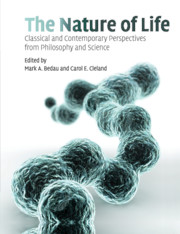Book contents
- Frontmatter
- Contents
- Preface
- Acknowledgments
- Sources
- About the authors
- Introduction
- SECTION I CLASSICAL DISCUSSIONS OF LIFE
- SECTION II THE ORIGIN AND EXTENT OF NATURAL LIFE
- SECTION III ARTIFICIAL LIFE AND SYNTHETIC BIOLOGY
- SECTION IV DEFINING AND EXPLAINING LIFE
- 23 Definitions of life
- 24 The seven pillars of life
- 25 A universal definition of life: autonomy and open-ended evolution
- 26 Does ‘life’ have a definition?
- 27 Sentient symphony
- 28 What is life?
- 29 Universal Darwinism
- 30 What is life? Was Schrödinger right?
- 31 Four puzzles about life
- Supplementary bibliography on life
- Index
- References
28 - What is life?
Published online by Cambridge University Press: 10 November 2010
- Frontmatter
- Contents
- Preface
- Acknowledgments
- Sources
- About the authors
- Introduction
- SECTION I CLASSICAL DISCUSSIONS OF LIFE
- SECTION II THE ORIGIN AND EXTENT OF NATURAL LIFE
- SECTION III ARTIFICIAL LIFE AND SYNTHETIC BIOLOGY
- SECTION IV DEFINING AND EXPLAINING LIFE
- 23 Definitions of life
- 24 The seven pillars of life
- 25 A universal definition of life: autonomy and open-ended evolution
- 26 Does ‘life’ have a definition?
- 27 Sentient symphony
- 28 What is life?
- 29 Universal Darwinism
- 30 What is life? Was Schrödinger right?
- 31 Four puzzles about life
- Supplementary bibliography on life
- Index
- References
Summary
DEFINING LIFE
Definitions explain the meaning of a term by relating the defined term to other expressions in the language. For example, a definition of acid specifies the necessary and sufficient conditions that all, and only, acids share. More generally, definitions relate items in a language to other items in that language. Some of these other terms, in turn, may have their meanings explained through definitions. But at some point the chain of definitions must end. Some concepts must be understood without the help of other verbal formulae. So in semantics and psychology, it is now realized that our capacity to use concepts and refer to kinds need not depend on a grasp, implicit or explicit, on the necessary and sufficient conditions of membership of those categories. Humans have been able to use terms for chemical and physical kinds (iron, liquid, salt, planet) long before they understood the nature of those kinds. Though natural kinds may have essences, those essences are discovered not through the construction of definitions at the beginning of inquiry, but, if we are lucky, as the culmination of inquiry.
So biologists do not need a definition of life to help them recognize what they are talking about. But definitions are often useful. When categories overlap, or are easily confused with one another, the precision induced by definition is important, for definitions enable us to notice important distinctions that are easily overlooked.
- Type
- Chapter
- Information
- The Nature of LifeClassical and Contemporary Perspectives from Philosophy and Science, pp. 355 - 359Publisher: Cambridge University PressPrint publication year: 2010
References
- 1
- Cited by



